Are your employees a bunch of thieves? Shockingly enough, 75% of workers admit to having stolen at least once from their employer. Stealing a pen or other office supplies might seem insignificant, but it adds up over time. Plus, employee theft doesn’t end there. Internal fraudsters cost companies worldwide a whopping $4.5 trillion annually. Yes, your employees can pocket up to 5% of your annual revenue if you don’t have effective fraud control practices in place.
We gathered the most eye-opening employee theft statistics to educate you on the topic and help you implement the best methods to prevent and detect employee theft.
Employee Theft Statistics (Editor’s Choice)
- 95% of all businesses fall victim to employee theft.
- Three-quarters of employees admit to having stolen at least once from their workplace.
- Employee theft costs US businesses between $20 billion and $50 billion annually.
- Employee time theft costs organizations $400 billion annually in lost productivity.
- The average time it takes for an employee fraud to get uncovered is 14 months.
- Businesses lose $4.5 trillion, or 5% of their revenue, to employee fraud each year.
- Fraudulent executives cause the highest median loss of $600,000.
- 75% of workers admit theyâve stolen at least once from their workplace.
Employee Theft Statistics Worldwide
1. Occupational fraud is the most prevalent in organizations.
Since 1996, ACFE’s global report has examined thousands of employee fraud cases, concluding that almost every organization is somehow exposed to the danger of employee theft. Its most recent findings are based on 2,504 examined cases of employee fraud from 125 countries. To mitigate the risk of hiring dishonest employees, organizations need to partner with reputable employment background check companies, perform ongoing screenings, establish solid internal controls, and nurture a positive culture that elevates morale, motivation, and satisfaction.
(ACFE)
2. 2,504 examined cases of employee theft in 2020 have caused $3.6 billion in total losses.
This number translates to a $125,000 median loss per employee fraud case. The examined cases represent only a tiny fraction of all employee theft cases globally. These employee theft statistics show that the affected organizations experienced an average of $1,509,000 in losses per case. The median duration of a fraud scheme is 14 months, and it causes an average loss of $8,300 per month.
(ACFE)
3. Asset misappropriation schemes are the most common but cause the lowest median loss.
Corruption schemes have a prevalence of 43% and cause a median loss of $200,000. Financial statement fraud schemes are the least common, yet these employee frauds have the highest median loss and cost businesses the most.
(ACFE)
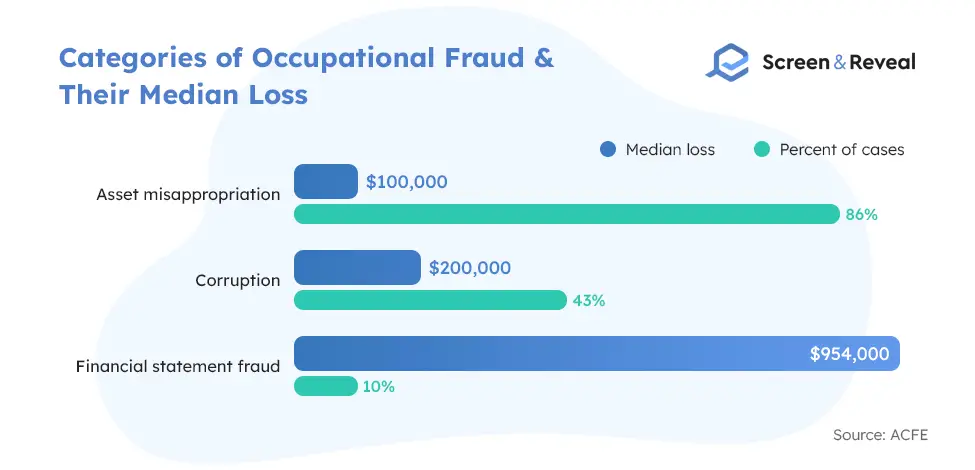
4. Stats on employee theft show that 43% of employee fraud cases were detected by tips in 2020, making them the most common initial detection method.
Employees provide over half of the tips, while one-third of the information comes from outside parties. Organizations with fraud awareness training are far more effective in detecting employee fraud through formal reporting mechanisms, as 56% of tips are gathered with training, compared to 37% without training.
(ACFE)
5. Organizations without hotlines report nearly double the median loss of organizations with hotlines.
The median loss for organizations without hotlines was $198,000 in 2020, partially because they were slower to detect the frauds with an average time of 18 months. Meanwhile, organizations with hotlines reported a median loss of $100,000 and 12 months median duration of the scams.
(ACFE)
6. Internal theft statistics suggest that telephone hotlines, email, and web-based forms were the most popular reporting mechanisms in 2020.
Telephone hotlines continue to be the most common place to unveil occupational fraud. Other popular reporting mechanisms include email, and online or web-based forms, while traditional letters and fax are less popular among reporters of employee fraud.
(ACFE)

7. 70% of occupational frauds occurred in for-profit organizations in 2020.
Out of those, 44% were private companies, and 26% were public companies. Private and public organizations suffered a median loss of $150,000. Only 9% of nonprofit organizations have reported occupational fraud. Although nonprofits reported significantly lower losses, these organizations operate with limited resources, and occupational fraud causes severe damage to their work and reputation.
(ACFE)

8. Small businesses with fewer than 100 employees are more affected by some fraud employee schemes.
Small businesses are twice more at risk of billing and payroll frauds and four times more likely to experience check and payment tampering. Large organizations employing 100+ employees, on the other hand, reported a median loss of $104,000 in 2018. Median losses for businesses are much higher when fraudsters join their forces.
(ACFE)
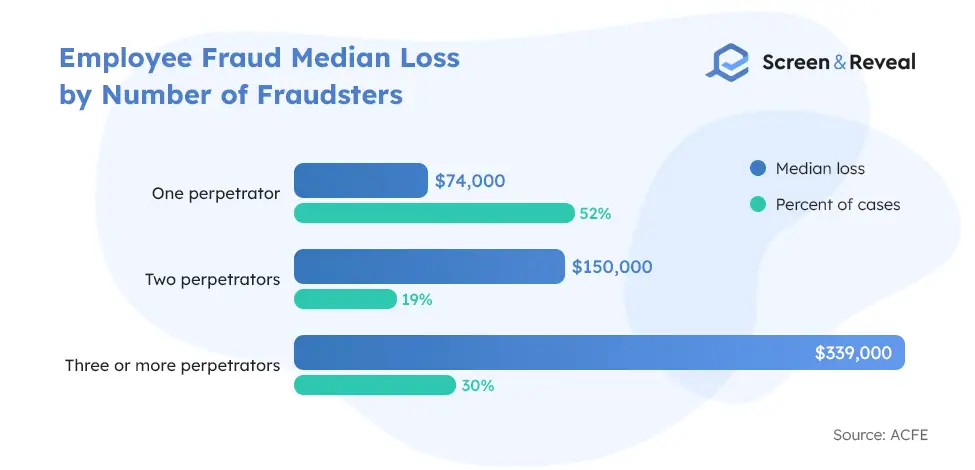
9. Workplace theft statistics indicate that lack of internal control contributes to one-third of occupational frauds.
In recent years there has been an increase in the use of targeted anti-fraud controls. Hotlines and anti-fraud policies recorded a 13% increase, fraud training for employees increased by 11%, and fraud training for managers and executives recorded a 9% increase.
(ACFE)
10. Male employees are more likely to be involved in employee theft.
The latest data indicates that 72% of fraudsters are men, causing a median loss of $150,000 compared to $85,000 in losses caused by women. Only 20% were owners or executives among fraudsters, yet these individuals have generated the highest losses.
(ACFE)
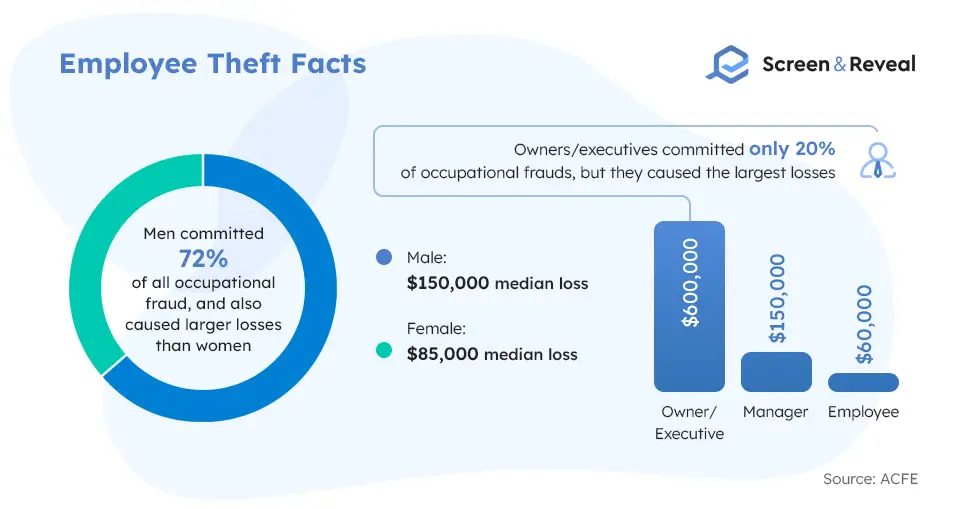
11. Stats on employee theft uncover that owners or executives cause the highest median loss of $600,000.
Managers come in second, and employees are last with ten times lower median loss than owners or executives. Professionals working in four particular departments are also more likely to engage in fraud. Half of the occupational frauds come from four major departments.
(ACFE)
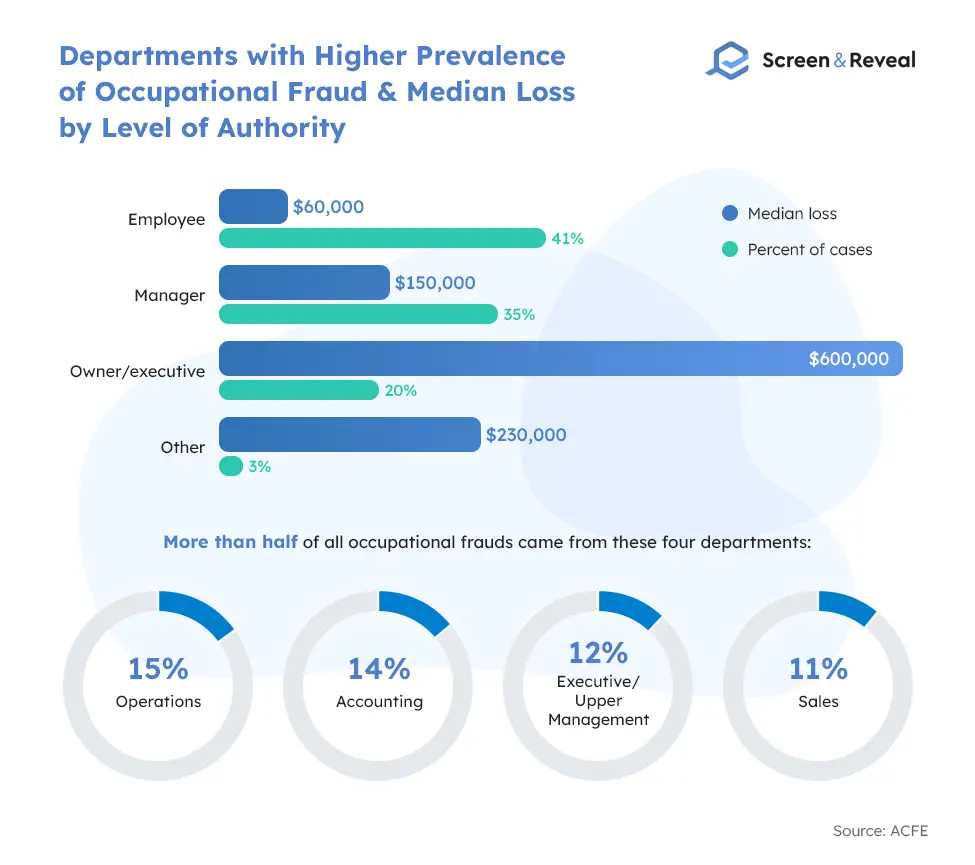
12. Employees who have been with the organizations longer steal twice as much as employees with less experience.
The median loss caused by long-term employees working for organizations for over five years is $200,000, compared to $100,000 for those employed for less than five years.
(ACFE)
13. According to internal theft statistics, 42% of occupational fraudsters were living beyond their means.
Data shows that employees don’t steal only because they hold a grudge against their employer. In the majority of cases, employees face financial hardships. In fact, 26% of occupational fraudsters were experiencing financial difficulties that made them perpetrate theft in the workplace.
(ACFE)
14. Organizations lose 5% of revenue to fraud annually.
That’s more than $4.5 trillion globally each year! Given that approximately 21% of occupational fraud cases in 2020 have caused losses more significant than one million dollars, this number makes sense on a global level.
(ACFE)
15. Restaurant employee theft statistics collected by the United States Chamber of Commerce point to an annual revenue loss between $40 and $400 billion due to employee thefts.
Employee theft is a severe problem in the foodservice industry, responsible for three-quarters (75%) of inventory shortages and 4% of restaurant sales. It also causes 50% of small business failure in the first year of business. Stealing food and liquor inventory, unpaid food consumption, credit card fraud, stealing tips, granting unauthorized discounts, and food given to friends or family for free are just a few examples of employee theft in the restaurant industry.
(UMASS)
Employee Time Theft Statistics
16. One in four employees confesses to reporting more hours than they work.
A whopping 43% of employees steal time from their organizations between 76% and 100% of cases. Given that time theft is one of the most expensive forms of employee theft, costing businesses $400 billion annually in lost productivity, organizations must invest in proven tools to reduce these tremendous losses. Time and attendance software that relies on biometric clocks is among the most effective tools to fight employee time theft as only 3% of employees manage to steal hours this way.
(Software Advice)
17. According to employee time theft statistics, recording inaccurate hours is the most popular form of time theft in the workplace.
45% of employee time thieves admit to recording inaccurate hours, followed by 43% who steal time through personal activities. Time theft is not always a result of bad intentions. Clocking in early or staying in later than the determined shift is another form of time theft that can build up significant unplanned expenses for companies.
(Software Advice)
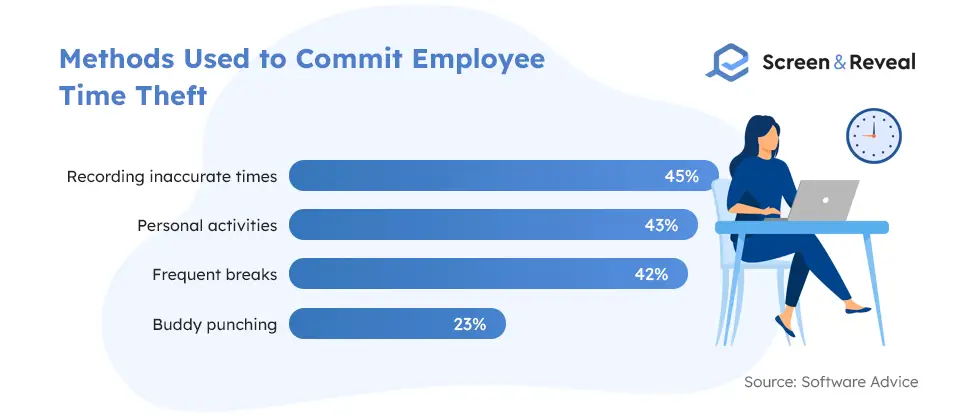
18. Employee time theft statistics reveal buddy punching costs companies around $373 million annually.
Employees would often ask trusted coworkers to clock them in when they were running late. When more employees do this repeatedly, clocking in 15-20 or more minutes earlier than they actually start working, that’s a significant amount of stolen time that organizations pay for.
(HR Daily Advisor)
19. Just under half of the shift employees inflate their working hours.
One-quarter of those who inflate their hours do so over 75% of the time. Employee theft statistics unveil a concerning frequency of recording inaccurate hours, costing businesses major unexpected expenses.
(Software Advice)

20. The majority of shift workers steal between 11 and 20 minutes per shift.
Although these numbers might look insignificant, employee time theft statistics show that the average employee gets paid for 50 minutes to four and a half hours they didn’t spend working. Showing up late, leaving early, and taking extended breaks build up around six weeks of stolen work time per employee annually. Multiply this by 50, 100, or more employees, and you’ll get staggering amounts of time that organizations lose.
(Software Advice)
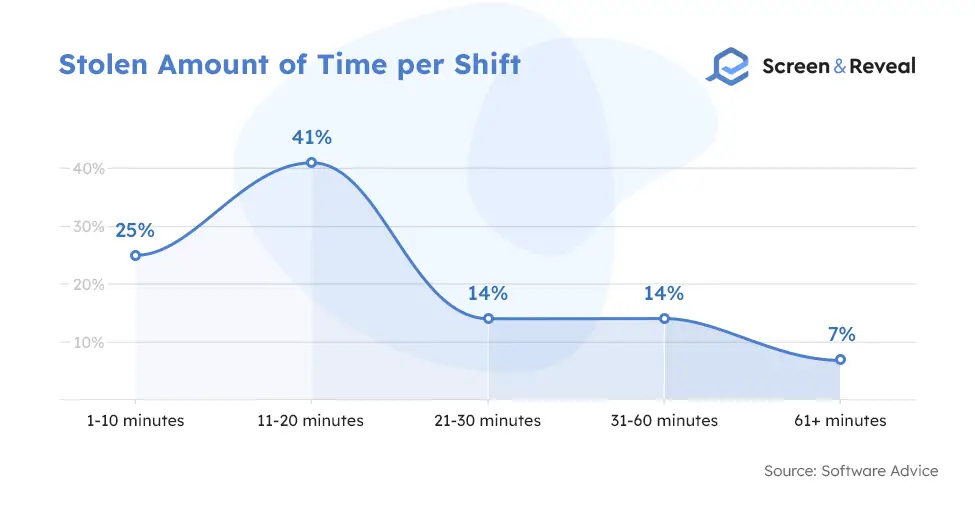
21. Online web portals are the most commonly used time-tracking devices to steal work time.
Biometric clocks, on the other hand, have proven to be the most effective in reducing employee time theft, yet they are the least used tracking tool. According to employee time theft statistics, the most common time-tracking devices employees use to steal time include web portals, mounted wall clocks, and paper forms.
(Software Advice)
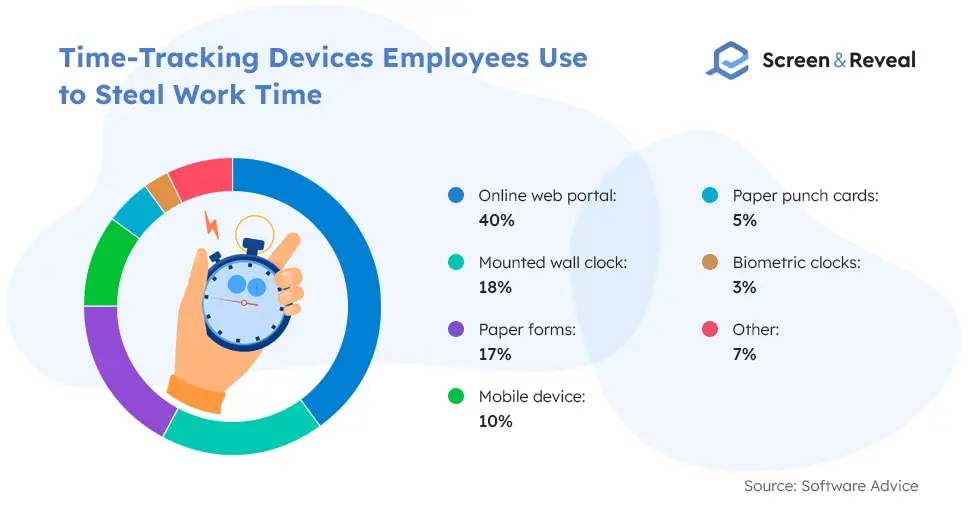
Employee Data Theft Statistics
22. The average cost of an insider attack accounted for a staggering $11.45 million in 2020.
From a total of 204 benchmarked IT organizations, a study discovered 4,716 internal thefts that have caused an average loss of $11.45 million. That’s a 31% increase from $8.76 million in 2018. Insider threat statistics show that internal incidents have also increased by 47% between 2018 and 2020, from 3,200 to 4,700. The numbers show that internal threats are often under-addressed and overlooked, yet they require serious attention just as external threats do.
(Ponemon Institute)
23. Internal theft statistics indicate that Incidents related to negligence are the most common internal threats among IT and cybersecurity organizations, accounting for 62% of all internal threats and causing an annual loss of $4.58 million.
23% of internal thefts happen due to criminal insiders and cost businesses $4.08 million annually. That’s an average of $756,760 per incident. 14% are related to user credential theft, causing damage of $2.79 million annually.
(Ponemon Institute)
24. Insider threats are behind 57% of database breaches.
A fifth of cybersecurity incidents and 15% of data breaches result from the misuse of privileges, although 61% of internal criminals don’t have high-level access or stature. Only 4% of insider and privilege misuse data breaches have been unveiled by fraud detection practices.
(Verizon)
25. Employee data theft statistics show that the top motivator for insider data theft and privilege misuse is financial gain (47.8%).
Historically, money has been the primary motivation behind misusing data. Interestingly enough, employees misuse data for fun as well! Those who have access to criminal records are often tempted to check someone they met on Tinder or search for records on friends, relatives, or acquaintances. While it’s legal to check for someone’s records and possible criminal history on people search sites, using work-related confidential sources for personal reasons is strictly forbidden. Employees who can access financial information might get into individuals’ accounts and history out of curiosity. Healthcare professionals can also dig into records for patients who are not in their care.
With 23.4%, fun (including curiosity and pride) is the second biggest motivator for employees to misuse data, followed by espionage with 14.4%. With less than 10% prevalence, other motivators include convenience, grudge, ideology, and fear.
(Verizon)
26. According to employee data theft statistics, healthcare and social assistance (46.4%) is the top industry where privileged threat actors cause the most damage.
Healthcare is the industry where internal threat actors cause the most breaches. To mitigate this risk, healthcare employers should partner with reputable healthcare background check companies that offer screening programs and ongoing monitoring tailored to meet the strict regulations in this industry. Public administration (18.5%) is second on the list, followed by professional, scientific, and technical services, financial insurance, manufacturing, retail trade, real estate, rental and leasing, mining, quarrying, and oil and gas extraction and accommodation and food services.
(Verizon)
27. With 69.6%, servers are the most affected asset due to insider and privilege misuse.
According to employee data theft statistics, media (13.8%), user devices (12.5%), and person (11.2%) are also among the top affected assets in cases of insider breaches and privilege misuse breaches.
(Verizon)
28. Medical data (44.9%) is the most targeted type of information among insider and privilege misuse breaches.
Personal data (32.1%) and internal data (14.8%) are also commonly targeted types of information by insider and privilege misuse actors. Other data types include secrets, payment, credentials, bank, source, classified, and copyrighted.
(Verizon)
Retail Employee Theft Statistics
29. The average 2019 shrink rate in the retail industry is 1.62%, costing the sector a whopping $61.7 billion.
While it seems like an insignificant percentage, it actually translates into a loss of billions of dollars per year. This loss comes as a result of both external shoplifting and internal theft in retail. In 2019, seven out of 10 companies reported a shrink rate higher than 1% compared to more than half in 2018. Almost twice as many (18.2%) in 2019 reported a shrink rate higher than 3% compared to 2018 (10.9%).
(CDN NRF)
30. The average number of dishonest employee terminations dropped to 558.6 in 2019.
Retail employee theft statistics show a slight decrease from 651.6 in 2014, yet way up from 335 in 2018. The median number of dishonest terminations was 169 in 2019, down from 122.5 in 2018.
(CDN NRF)
31. There was an average of 560 apprehensions made against employees who’ve committed internal theft in retail in 2019.
This marks a dramatic increase from 322.6 in 2018. The median number of apprehensions made against dishonest retail employees was 191 in 2019, compared to 76 in 2018.
(CDN NRF)
32. There was an average of 156 prosecutions made against fraudulent retail workers in 2019.
The average number of prosecutions has increased from 91.3 in 2018. The median number went from 28 in 2018 to 40 in 2019, criminal record statistics show.
(CDN NRF)
33. According to employee theft statistics in retail, the average number of civil demands against employee fraudsters reached 283.4 in 2019.
In 2018, the average number was 159.8. The median number meanwhile went from 18 in 2018 to 32 in 2019.
(CDN NRF)
34. The average loss per dishonest retail employee was $1,139.32, slightly down from $1,264.10 in 2018.
The average loss has had its ups and downs over the years, reaching its highest in 2016.
(CDN NRF)
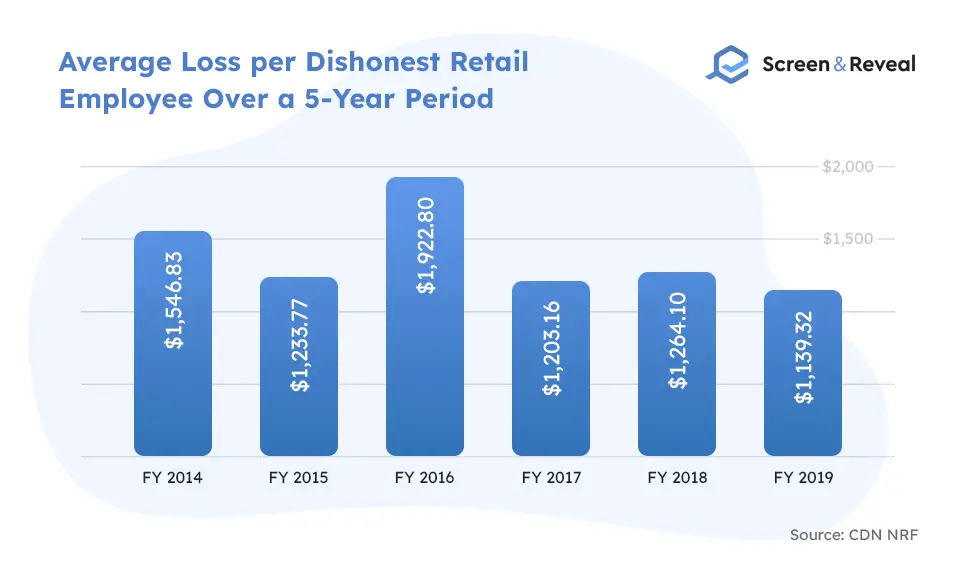
35. According to employee theft statistics, the highest percentage of retail companies (24.3%) have lost between $500 and $749 per employee.
Only 3% of retail companies reported losses greater than $5,000. Below, you can see a full breakdown of the average loss per fraudulent retail employee.
(CDN NRF)
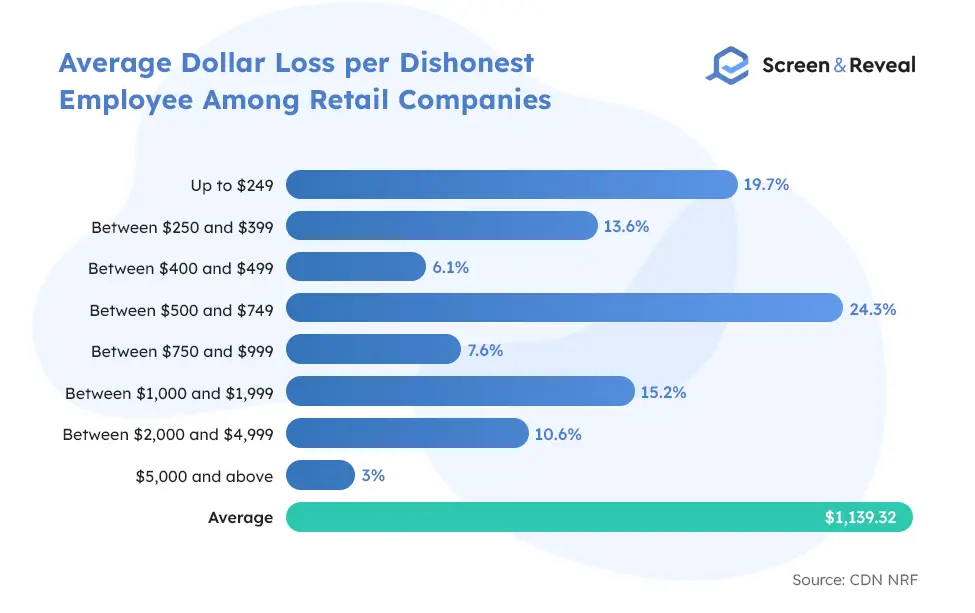
36. Retail employee theft statistics indicate retail companies with 500 or fewer locations had a higher average loss per dishonest employee theft case in 2018, averaging $1,377.12
Retailers with more than 500 locations had an average loss of $1,172.63 per dishonest employee case in 2018. More than half of retailers (53.7%) report employee thefts of less than $1,000, which is the national average felony threshold.
(CDN NRF)
37. 75% of employees admit they have stolen at least once from their employers.
Half of those have stolen more than twice. To reduce these instances, employers must create a positive culture where their workers feel valued and appreciated, as well as use technology to minimize and prevent theft.
(SMG)
38. Shocking workplace theft statistics unveil 30% of business bankruptcies are due to employee theft.
A concerning number of companies are forced to close down due to repeated and often long-term fraudulent actions committed by employees. Data shows that employees are responsible for over $50 billion of losses for US businesses annually. While most companies focus on installing security cameras and other systems that protect them from shoplifting, data shows that employees steal approximately 5.5 times more than shoplifters. A staggering 34% of employees aged 18 to 29 believe it’s justifiable to steal from their employer.
(SMG)
Embezzlement Statistics
39. The average embezzlement case lasts more than two years, creating an average loss of $357,650.
In 79% of embezzlement cases, the fraud has been carried out by more than one employee, and in 46% of cases, three or more employees played a role. 70% of the cases last for more than one year, while 31% for three years or longer. Aside from monetary losses, companies victims of embezzlement lost customers, potential customers, business partners, and in some cases — their reputation.
(Hiscox)
40. More than half of companies victims of embezzlement recover less than one-third of the damage.
While embezzlement statistics show that no business size or industry is immune to embezzlement, three-quarters of organizations don’t have insurance to cover embezzlement. To protect their business, companies must establish systems to help them detect and prevent embezzlement schemes and suspicious behavior.
(Hiscox)
41. 85% of embezzlement cases were committed by someone at the manager level or above.
33% of those were working in accounting or finance roles, positions with access to sensitive information. In one-fifth of theft cases, C-level executives were involved. More experienced employees are also more likely to walk on the other side of the law as they have a good understanding of how things work and who might be susceptible to join them. Eight years is the average period of time an embezzler has been working in a company.
(Hiscox)
42. Embezzlement statistics show that in more than half of embezzlement cases, the fraudsters get only fired, free to find their next victim.
Companies must take legal actions against internal thieves. This way, criminal background check companies will be able to track and disclose any criminal history, including pending charges, when these fraudulent individuals apply for a new job.
In 65% of cases, someone from the organization uncovers the embezzlement scheme, yet not every company presses charges against the embezzler. It happens in only 45% of cases, and 58% of those result in convictions.
(Hiscox)
43. Billing fraud is the most popular technique among embezzlers.
Billing fraud involves creating fictitious vendors, inaccurate reporting spending, and overstating payments. Other methods embezzlers rely on include theft of cash, other types of theft and larceny, check and payment tampering, payroll fraud, skimming, and cash larceny.
(Hiscox)
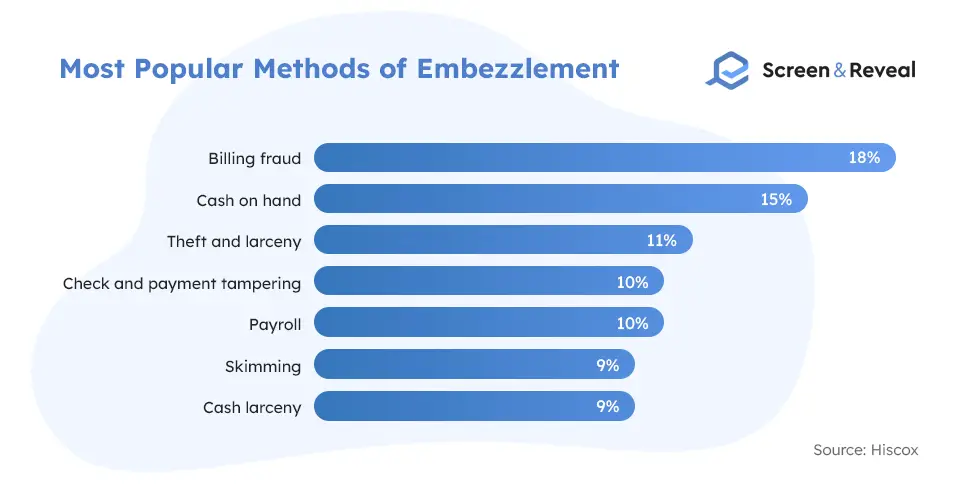
44. Embezzlement statistics show that the median age of an employee embezzler is 48 years old.
Employees of any age can commit embezzlement, yet more experienced employees feel more confident doing so. Slightly more men (51%) than women (49%) get involved in embezzlement. Unsurprisingly, 37% of embezzlers work in accounting and finance positions. The typical embezzler may show some of these characteristics: intelligent, curious, extravagant, egotistical risk-taker, diligent, ambitious, and disgruntled.
(Hiscox)
Employee Theft Facts by Country
45. Employee theft statistics for Canada reveal the median loss of occupational fraud is $200,000.
40% of fraud cases in Canada involve corruption, followed by 20% billing cases, 18% non-cash fraud, 14% financial statement fraud, 13% skimming, 13% cash on hand, 11% expense reimbursements, 10% check, and payment tampering, 6% payroll, 3% register disbursements, and 3% cash larceny.
(ACFE)
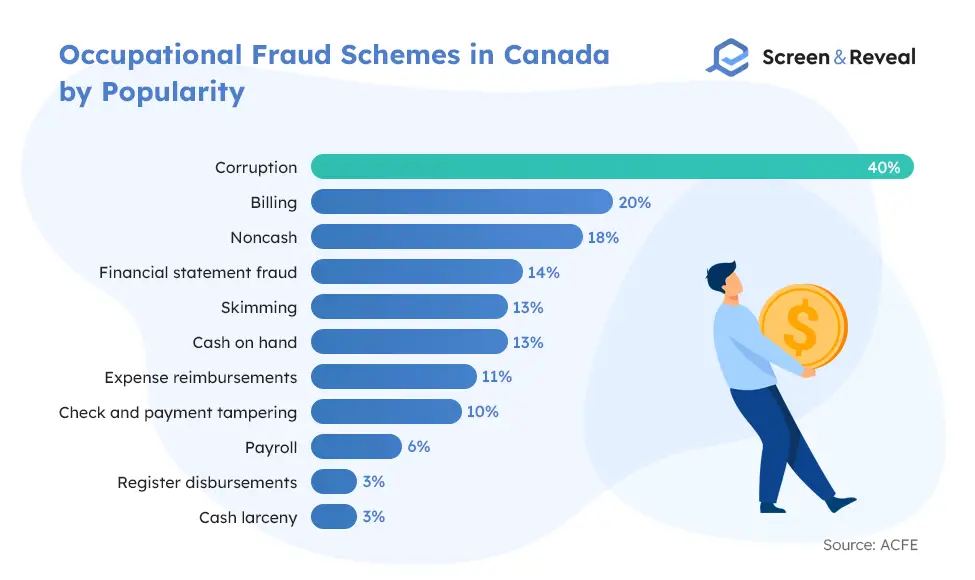
46. 47% of occupational perpetrators in Canada are employees, causing a median loss of $156,000.
27% of fraudsters are in managerial positions, creating a median loss of $205,000, and 23% are owners or executives, causing median damage of $600,000. Men comprise the majority of employee theft perpetrators (69%) compared to 31% of women.
(ACFE)
47. Employee theft statistics show UK businesses lose £190 million annually due to dishonest employees.
Employee fraud is responsible for 40% of £190 million, or £76 million annually. Fraudsters steal in different ways, but the most common are inventory theft, data theft, and cash theft. Other forms of employee theft include time theft, payroll theft, and theft of services.
(Delta 74)
48. Between 2019 and 2020, 8,958 employee theft cases were reported to the police in England and Wales.
The data shows a steady decrease over the years, with the lowest number of reported employee theft cases between 2019 and 2020, since 2002, when the police received 17,530 reports. The period between 2003 and 2004 marks the most cases reported — 17,700.
(Statista)
49. Employee theft statistics for Australia reveal that 70% of all workplace fraud Down Under was perpetrated by current or former employees.
The Australian Federal Police reveals that employee theft costs Aussie businesses up to $1.5 billion a year.
(Money Australia)
50. Around 80% of Australian employees have considered committing employee theft.
While employee theft is present in all sectors, some industries are more affected than others. Australian retailers, for example, lost $3 billion due to retail shrinkage. Data shows that employees were responsible for a staggering $750 million of this amount.
(HRM)
Employee Theft FAQ
What percentage of employees steal?
Stats on employee theft show that over 75% of employees admit they have stolen at least once from an employer, and half of those admit having stolen more than twice.
How common is employee theft?
Employee theft is widespread. 95% of US businesses fall victim to it, and employees are responsible for 90% of all significant theft losses.
How many employees steal?
Workplace theft statistics show three out of four employees admit to having stolen from their employers at least once, meaning that 75% of employees have engaged in employee theft at least once in their life.
How much do companies lose from employee theft?
Every year, employee theft costs US businesses up to $50 billion.
Why do employees steal?
In general, we could divide the motives of employee theft into the following three categories:
- Pressure
Many employees who steal actually go through some financial difficulties, so they need to solve them somehow.
- Opportunity
Workplace theft statistics show that employees that have access to funds and assets often get tempted by the idea to take a piece of the cake, expecting that no one will ever find out.
- Rationalization
Sometimes employees get angry, disappointed, or dissatisfied with how the employer is treating them. In these cases, employees may justify the theft as revenge for the mistreatment.
Employee theft statistics show that the motive could be a combination of all three. For example, an employee is in a bad financial situation, mistreated at work, and feeling underpaid, and when an opportunity for theft presents itself — they take it.
Sources: ACFE, ACFE, UMASS, Software Advice, HR Daily Advisor, Ponemon Institute, Verizon, CDN NRF, SMG, Hiscox, Hiscox, Delta 74, Statista, Money Australia, HRM, California Restaurant Association.ACFE, ACFE, UMASS, Software Advice, HR Daily Advisor, Ponemon Institute, Verizon, CDN NRF, SMG, Hiscox, Hiscox, Delta 74, Statista, Money Australia, HRM, California Restaurant Association.

